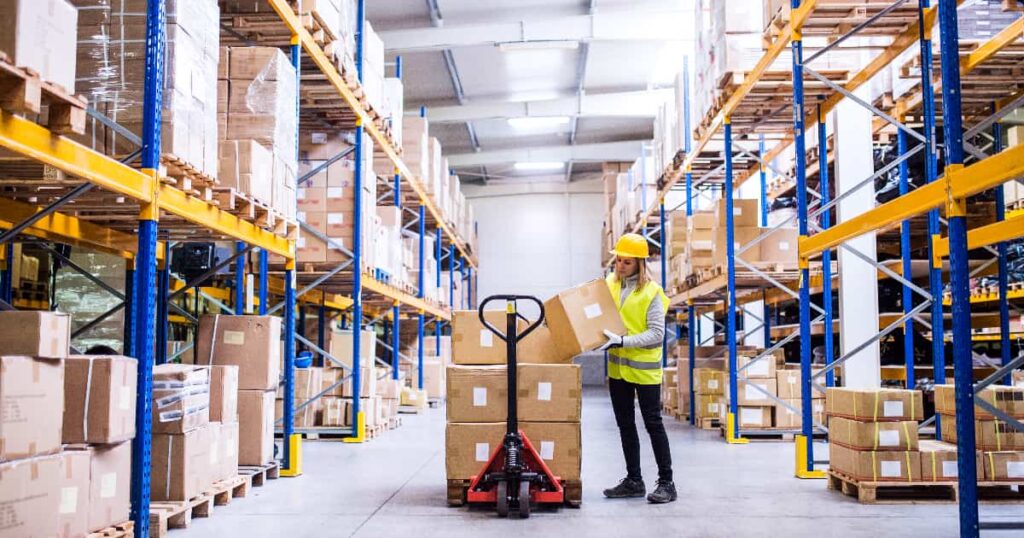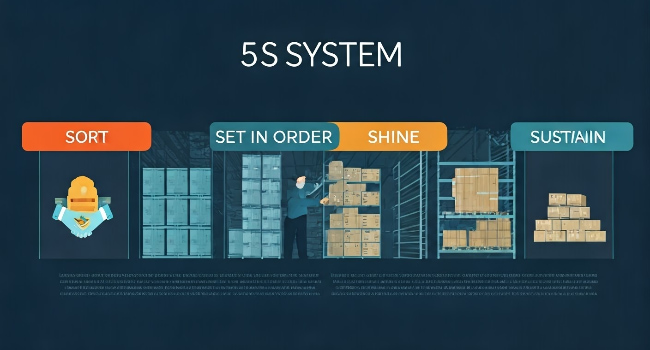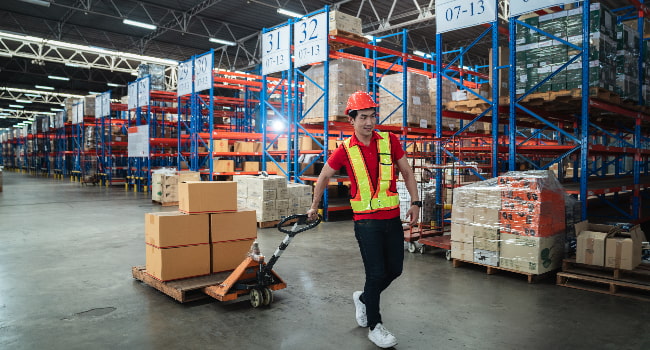A1 Quality Logistical Solutions

- By Haley
- January 2, 2025
Table of Contents
Key Highlights
- The 5S system, a workplace organization method, can significantly enhance warehouse operational efficiency.
- By implementing the 5S system, warehouses can experience reduced errors, increased productivity, and improved safety.
- The 5S methodology consists of five steps: Sort, Set in Order, Shine, Standardize, and Sustain.
- Each step in the 5S system contributes to a cleaner, more organized, and efficient warehouse environment.
- By optimizing warehouse processes, the 5S system leads to improved labor management and reduced labor costs.
Introduction
Good warehouse management means making all processes work better. This is where the 5S system can help. By using this trusted method, warehouses can make their operations smoother, cut down on waste, and greatly boost overall efficiency.
Understanding the 5S System in Warehouse Operations

The 5S system comes from Japan. It is a five-step method to organize a workplace. This method helps create and keep a work environment that is efficient and productive. The five steps are Sort, Set in Order, Shine, Standardize, and Sustain. These steps may seem simple, but they provide a thorough way to organize any workplace.
In warehouses, the 5S system reduces waste, improves workflow, and increases productivity. A clean, organized, and standardized warehouse helps businesses manage labor better, keep safety high, and improve operational efficiency.
The Origin and Principles of the 5S System
The 5S system was created by Toyota in the 1960s and quickly became a key part of their famous Toyota Production System. At first, it was meant for manufacturing plants, but became popular in many other areas, like warehouses. The main idea of the 5S system is that a clean and organized workplace improves efficiency and productivity.
This system helps to set standard operating procedures to keep workplaces organized. This makes it easier for workers to find tools, equipment, and inventory. When time is not wasted looking for lost items, workers can focus more on their main tasks. The success of the 5S system depends on every team member’s commitment and active involvement.
The 5S system also promotes a culture of continuous improvement. This encourages employees to take pride in their workspace and work towards better efficiency. As a result, this leads to higher employee engagement, better morale, and fewer mistakes. When the 5S system is adopted, it turns the warehouse into a more organized, efficient, and productive place.
How the 5S System Enhances Warehouse Efficiency
The 5S system helps improve warehouse efficiency in many ways. Firstly, it focuses on managing labor. By organizing the warehouse, tasks are easier and quicker to complete. Workers do not waste time looking for lost items or moving through messy areas. This saves time and boosts productivity.
In addition, a tidy workspace makes employees feel a sense of pride and ownership. This can raise morale and improve employee engagement. When workers care about their environment, they are more likely to keep things neat. This leads to long-lasting improvements in efficiency. Greater engagement means fewer mistakes, better accuracy, and higher accountability.
In the end, the 5S system creates a cycle of ongoing improvement. As employees see the benefits of a neatly organized space, they are more likely to help maintain and improve the system. This aids in boosting warehouse productivity and overall operational efficiency.
Implementing the First S: Sort

“Sort” is the first and most important step in the 5S system. It involves looking closely at the warehouse to find items that are not needed for daily work. This step needs careful thinking and a willingness to get rid of things that do not help anymore. By getting rid of old stock, broken tools, and unnecessary materials, warehouses can free up important space and reduce clutter.
The main aim of the “Sort” step is to make the workspace leaner and more efficient. It lays the groundwork for the next steps in the 5S system. This helps create a more organized way to manage the warehouse.
Identifying and Eliminating Unnecessary Items
Identifying and removing unnecessary items in a warehouse is required for making the best use of space. One effective method is the red tag technique. When you put a red tag on items that are not needed, old, or rarely used, it helps to spot them for removal. This approach helps the right people find what they need quickly.
Removing items that are not necessary directly affects labor costs. When workers can easily find what they are looking for, they spend less time looking and more time working. This increase in efficiency leads to higher productivity, fewer wasted hours, and lower overall labor costs.
Good warehouse management needs regular checks of inventory and equipment to decide what to keep, store, or remove. By encouraging a culture of continuous improvement and getting employees involved in the “Sort” process, warehouses can stay organized.
Strategies for Effective Sorting in Warehouses
Effective sorting is an ongoing task in warehouses that handle a lot of products, face changing demands, or are part of a complex supply chain. Using helpful strategies can make sorting easier and more efficient.
First, it is important to set clear rules for what is an unnecessary item. This can include looking at how often items are used, checking inventory turnover rates, and working with other departments in logistics and picking. Second, having special areas for sorted items can help make the removal process go smoothly. Having set zones for items that need to be thrown away, donated, or stored elsewhere can avoid confusion and help work flow better.
Here are some good strategies to think about:
- Use the FIFO method (First-In, First-Out) to make sure older inventory is sold or used first. This helps reduce waste.
- Introduce visual aids, like floor markings or color-coded bins, to make sorting and finding items easier.
- Train staff on the sorting rules and steps to maintain consistency.
Embracing the Second S: Set in Order

Once you remove unnecessary items, the “Set in Order” stage is all about organizing what’s left. The goal is to have everything in a specific spot so you can find it quickly. When you arrange the workspace well, warehouses can cut down the time spent looking for things. This helps with faster picking and packing, and it can lower mistakes in fulfilling orders.
Also, “Set in Order” helps make the workplace safer. By getting rid of clutter and keeping paths clear, warehouses can reduce accidents and injuries. Storing items in the right way stops damage and makes it easier to manage inventory.
Organizing Tools and Equipment for Optimal Workflow
Organizing tools and equipment improves speed and accuracy in fulfilling orders. When frequently used tools are placed in easy-to-reach spots, it helps employees spend less time looking for them. This makes workflows run smoother and helps get tasks done quickly without delays.
Ergonomics is also important when organizing tools and equipment. By thinking about the height, reach, and work style of employees, warehouses can make workspaces more comfortable and effective. Using clear signs, like labels and color codes, helps workers find and put back tools easily after using them.
These practices lead to real benefits in how warehouses operate. Less time wasted moving around to get tools, quicker finds for specific items, and a tidy workspace all help boost productivity and enhance overall performance.
Visual Management Techniques in Setting Everything in its Place
Visual management techniques offer a powerful tool for maintaining order and improving warehouse productivity. By providing clear visual cues, warehouses can guide employees, enhance communication, and minimize errors. Visual signals, such as floor markings to designate walkways and storage areas, color-coded labels for easy identification of inventory, and shadow boards for tools, contribute to a more efficient and organized working environment.
Metrics play a crucial role in tracking progress and identifying areas for improvement. Using visual management techniques, such as dashboards or graphs, to display key performance indicators (KPIs) allows employees to track progress easily, fostering a sense of accountability and encouraging them to strive for continuous improvement. Visualizing metrics provides transparency and helps identify bottlenecks or areas where adjustments are needed.
Visual Management Technique
Description
Floor Markings
Define walkways, work areas, and storage zones for clear navigation and organization.
Color-Coded Labels
Facilitate quick and easy identification of inventory, tools, and equipment.
Shadow Boards
Provide designated spots for tools, making them readily accessible and ensuring their proper return.
Applying the Third S: Shine

The third S, “Shine,” highlights how important it is to keep things clean and tidy at work. Cleaning regularly stops dust and mess from piling up while protecting products and equipment from breaking down. A clean space also makes workers feel proud, inspiring them to take care of where they work.
“Shine” means more than just cleaning. It also involves checking tools and work areas for any damage. Regular maintenance and fast repairs help equipment work well, which reduces delays and high costs. Moreover, a clean space creates a feeling of order and professionalism. This helps to make a good impression on clients and visitors.
Routine Cleaning Protocols to Maintain Warehouse Standards
Establishing regular cleaning routines is crucial for keeping warehouse standards high. Having clear standard operating procedures (SOPs) for cleaning chores helps make the process easier and ensures that every area is cleaned well. When specific cleaning tasks are given to people or teams, they feel a sense of ownership and responsibility.
You should add cleaning tasks to daily or weekly plans. This will help keep things on track. Also, using checklists can help employees mark off their completed tasks and remind them of what needs to be done. During busy times, adjusting the cleaning schedule or adding extra help for cleaning makes sure the workspace stays tidy and organized, even when things get busy.
Following labor standards is very important when putting these cleaning routines in place. Employees who have cleaning tasks should get proper training. This involves learning how to safely handle cleaning supplies and use the right cleaning methods. This helps lower the chances of accidents or injuries.
Preventive Maintenance for a Safer Warehouse Environment
Preventive maintenance is a key element for keeping a warehouse safe. When equipment is regularly checked, cleaned, and fixed, it can help prevent breakdowns or problems that lead to accidents. By taking care of maintenance early, safety features can work better, which lowers the chances of injuries at work.
Also, preventive maintenance helps equipment last longer. Regular checks can find small issues before they become big problems, which means less need for expensive repairs or replacements. This saves money and keeps the warehouse running smoothly. A well-kept work area shows that the company cares about employee safety, which can boost morale and job happiness.
When warehouses focus on preventive maintenance, they can lower downtime, make the workplace safer, and keep skilled workers. Spending on preventive maintenance is a good investment for the future and growth of warehouse operations.
Conclusion
In conclusion, the 5S System helps improve how warehouses run. This system works by using five steps: Sort, Set in Order, Shine, Standardize, and Sustain. Businesses can make their processes simpler, cut down on waste, and boost productivity by following these steps. Using the 5S System not only streamlines work but also builds a strong culture of improvement in the company. For it to work well, keep things organized, clean, and follow the set standards. The 5S method is a strong tool that can change how warehouses manage their operations. This change leads to better control of inventory and makes operations more effective. Start your path to better efficiency today with the 5S System!
Frequently Asked Questions
Are There Any Case Studies of Successful 5S Implementation in Warehouses?
Many case studies show how the 5S system helps improve warehouse operations. Companies in different industries have seen big boosts in efficiency, fewer mistakes, and better safety by using 5S. These success stories prove that the 5S system works well and offers real benefits in warehouses.
How can the 5S system help with inventory management in a warehouse setting?
The 5S system improves how a warehouse is organized. It helps people find and keep track of inventory easily. This clear method keeps inventory correct, cuts down on losses, and makes the picking and packing process better. When warehouses use the 5S system, they can be more efficient and accurate in managing inventory.

Haley serves as the Marketing Manager for A1 Quality Logistical Solutions. She joined A1QLS in 2023 with her prior experience gained with GXO and XPO Logistics.
